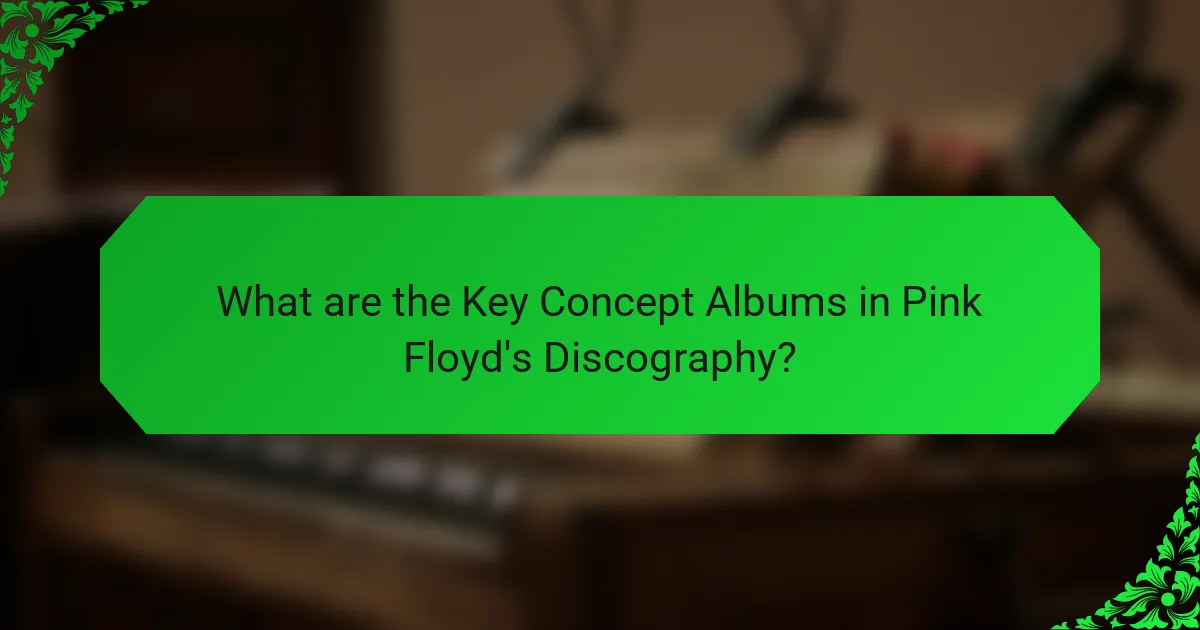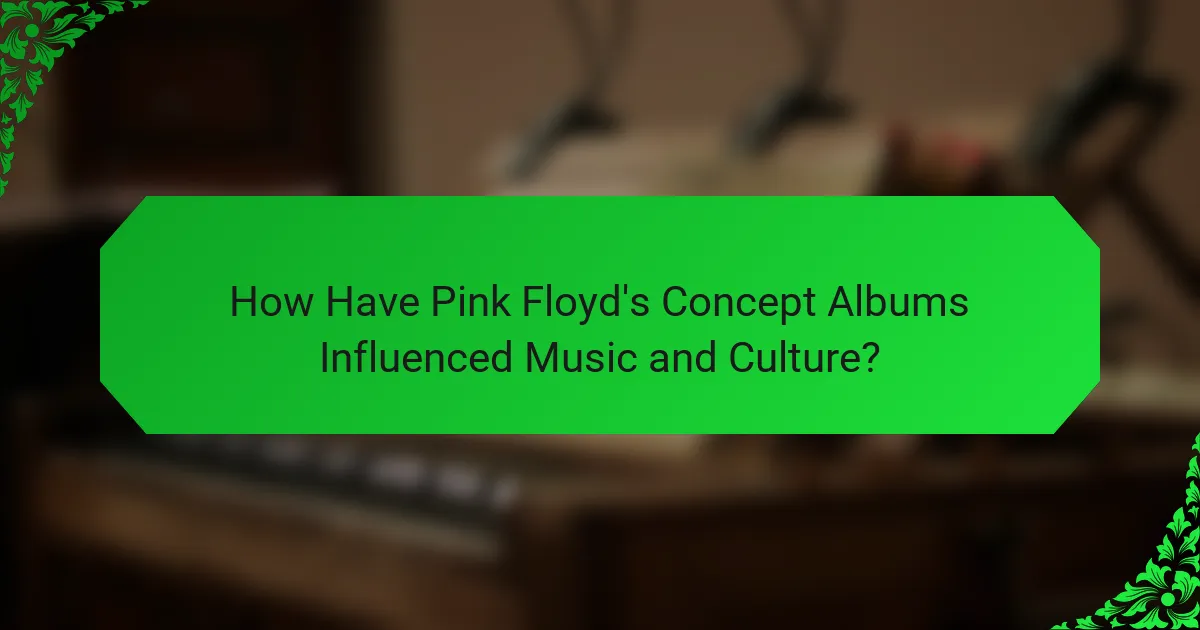Concept albums are musical works that tell a cohesive story or explore a central theme throughout their tracks. Pink Floyd is a prominent band known for their influential concept albums, including “The Dark Side of the Moon,” “The Wall,” “Wish You Were Here,” “Animals,” and “The Final Cut.” These albums address complex themes such as mental health, personal trauma, alienation, and societal critique, significantly impacting rock music and culture. “The Dark Side of the Moon” remains one of the best-selling albums of all time, while “The Wall” introduced a narrative structure that resonated with listeners. Pink Floyd’s innovative storytelling and visual artistry in their albums and live performances set new standards for the music industry.

What are Concept Albums and How Do They Relate to Pink Floyd?
Concept albums are musical works that tell a cohesive story or explore a central theme throughout their tracks. Pink Floyd is renowned for their use of concept albums, particularly with “The Dark Side of the Moon” and “The Wall.” These albums feature interconnected songs that create an overarching narrative. “The Dark Side of the Moon” addresses themes of mental health and the human experience. “The Wall” explores alienation and personal trauma. Both albums received critical acclaim and commercial success, solidifying Pink Floyd’s legacy in the genre. Their innovative approach to storytelling through music has influenced countless artists.
What defines a concept album in the context of music?
A concept album in music is defined as an album that tells a cohesive story or explores a specific theme throughout its tracks. Each song contributes to an overarching narrative or concept, creating a unified listening experience. This format often includes recurring musical motifs and lyrical themes. Notable examples include Pink Floyd’s “The Wall,” which addresses themes of isolation and alienation. Concept albums often challenge traditional song structures, emphasizing the flow between tracks. They can also incorporate interludes or spoken word segments to enhance the storytelling aspect. The concept album format has been influential in various genres, particularly rock and progressive music.
How do concept albums differ from traditional albums?
Concept albums differ from traditional albums by presenting a unified theme or narrative throughout the entire work. Traditional albums often consist of standalone tracks that may not relate to each other. Concept albums typically explore a specific story or idea, creating a cohesive listening experience. This format encourages deeper engagement with the music and lyrics. For example, Pink Floyd’s “The Wall” is a renowned concept album that tells a story of isolation and personal struggle. In contrast, traditional albums like a pop compilation may feature unrelated songs that vary in style and subject matter. The storytelling aspect in concept albums often leads to more complex musical arrangements and thematic development.
What are the common themes found in concept albums?
Common themes found in concept albums include storytelling, personal experiences, and social commentary. Storytelling often drives the narrative, creating a cohesive experience across tracks. Personal experiences may reflect the artist’s life, emotions, or struggles. Social commentary addresses societal issues or critiques, engaging listeners on deeper levels. Additionally, themes of isolation, mental health, and existentialism are prevalent in many concept albums. For instance, Pink Floyd’s “The Wall” explores themes of alienation and psychological trauma, illustrating how these themes manifest in their work.
Why did Pink Floyd choose to create concept albums?
Pink Floyd chose to create concept albums to explore complex themes and narratives. Their albums often convey a cohesive story or message, enhancing the listening experience. This approach allowed them to delve into topics like mental health, war, and existentialism. For instance, “The Dark Side of the Moon” addresses the pressures of life and insanity. The band’s desire for artistic expression drove this choice. Concept albums also distinguished them in the progressive rock genre. Their innovative sound and thematic depth attracted a dedicated fan base. This strategy solidified their legacy in music history.
What influences shaped Pink Floyd’s decision to focus on concept albums?
Pink Floyd’s decision to focus on concept albums was influenced by their desire for artistic expression and narrative coherence. The band sought to create immersive experiences that conveyed complex themes. Their early work, particularly “The Piper at the Gates of Dawn,” showcased experimental elements that set the stage for future concept albums. The success of “The Dark Side of the Moon” demonstrated the commercial viability of this format. Additionally, societal and psychological themes, such as mental health and existentialism, shaped their lyrical content. The band’s collaboration with visual artists also enhanced their storytelling approach. Overall, these influences led Pink Floyd to prioritize cohesive musical narratives in their discography.
How did the cultural context of the time impact their work?
The cultural context of the time significantly influenced Pink Floyd’s work. The band emerged during the 1960s, a period marked by social upheaval and counterculture movements. This environment fostered a desire for artistic expression and experimentation. The rise of psychedelic culture encouraged innovative soundscapes and lyrical themes. Events such as the Vietnam War and civil rights movements shaped their perspectives. Pink Floyd’s albums often reflected these societal issues, resonating with listeners. Their use of concept albums allowed for deeper storytelling and exploration of existential themes. The cultural backdrop provided both inspiration and a platform for their unique sound.

What are the Key Concept Albums in Pink Floyd’s Discography?
The key concept albums in Pink Floyd’s discography are “The Dark Side of the Moon,” “Wish You Were Here,” “Animals,” “The Wall,” and “The Final Cut.” “The Dark Side of the Moon,” released in 1973, explores themes of mental illness and existentialism. It is one of the best-selling albums of all time. “Wish You Were Here,” released in 1975, is a tribute to former member Syd Barrett. It addresses themes of absence and disillusionment. “Animals,” released in 1977, uses animal imagery to critique society and capitalism. “The Wall,” released in 1979, tells a narrative of isolation and personal trauma. It features the hit song “Another Brick in the Wall.” “The Final Cut,” released in 1983, reflects on war and loss. These albums significantly shaped the landscape of rock music and concept albums.
Which albums are considered major concept albums by Pink Floyd?
The major concept albums by Pink Floyd are “The Dark Side of the Moon,” “Wish You Were Here,” “Animals,” “The Wall,” and “The Final Cut.” “The Dark Side of the Moon,” released in 1973, explores themes of mental illness and societal pressures. “Wish You Were Here,” from 1975, pays tribute to former band member Syd Barrett. “Animals,” released in 1977, critiques capitalism through allegorical animals. “The Wall,” from 1979, tells a narrative of isolation and alienation. “The Final Cut,” released in 1983, serves as a commentary on war and loss. These albums are recognized for their cohesive themes and storytelling.
What themes are explored in “The Dark Side of the Moon”?
“The Dark Side of the Moon” explores themes of mental illness, existentialism, and the passage of time. The album addresses the pressures of modern life and the impact on the human psyche. It delves into the struggles with sanity, as evidenced by the song “Brain Damage.” Additionally, it reflects on the inevitability of death and the human experience, highlighted in tracks like “Time.” The theme of conflict between personal desires and societal expectations is also prominent. The cohesive nature of the album allows these themes to interconnect, creating a profound commentary on life and human condition.
How does “The Wall” illustrate the concept album format?
“The Wall” exemplifies the concept album format through its cohesive narrative and thematic development. The album tells a story of isolation and personal struggle, following the character Pink. Each song contributes to this overarching narrative, creating a unified listening experience. The transitions between tracks enhance the storytelling aspect. Additionally, “The Wall” incorporates musical motifs that recur throughout the album, reinforcing its themes. The use of interludes and sound effects further immerses listeners in the narrative. Released in 1979, it is widely regarded as one of the quintessential concept albums. The critical and commercial success of “The Wall” solidified its status in music history as a benchmark for the concept album format.
What role did storytelling play in Pink Floyd’s concept albums?
Storytelling played a crucial role in Pink Floyd’s concept albums. It provided a narrative framework that connected the songs cohesively. Each album often explored complex themes such as alienation, mental health, and societal issues. For example, “The Wall” tells the story of a character’s isolation and descent into madness. This narrative approach enhances listener engagement and emotional impact. The use of recurring motifs and characters creates a unified artistic vision. Additionally, storytelling allowed for deeper exploration of philosophical questions. Pink Floyd’s albums often transcend mere music, becoming immersive experiences. This emphasis on storytelling distinguishes their work in the rock genre.
How are narratives constructed within these albums?
Narratives in Pink Floyd’s concept albums are constructed through interconnected musical themes and lyrical storytelling. Each album often follows a central concept or story arc that unfolds across tracks. For example, “The Wall” presents a narrative of isolation and alienation through the character Pink. The music complements the lyrics, using soundscapes to enhance emotional depth. Instrumental transitions also serve to bridge narrative elements between songs. Additionally, recurring motifs and symbols reinforce the overarching themes. The use of dialogue and sound effects further immerses listeners in the narrative experience. Overall, these techniques create a cohesive and engaging storytelling format within the albums.
What techniques did Pink Floyd use to enhance storytelling?
Pink Floyd used various techniques to enhance storytelling in their music. They employed concept albums to create cohesive narratives. Each album often revolves around a central theme, such as alienation or mental health. The band integrated sound effects to evoke specific emotions and settings. They also utilized extended instrumental sections to build atmosphere. Lyrics were crafted to convey deep philosophical messages. Visual elements, including elaborate album artwork and live performances, complemented the music. Their use of character development in songs added depth to the narratives. Overall, these techniques contributed to a rich, immersive storytelling experience.

How Have Pink Floyd’s Concept Albums Influenced Music and Culture?
Pink Floyd’s concept albums have profoundly influenced music and culture by pioneering the integration of thematic storytelling in rock music. Their album “The Dark Side of the Moon” is a landmark in this genre, exploring complex themes like mental illness and existentialism. This album spent over 900 weeks on the Billboard charts, highlighting its cultural impact.
Similarly, “The Wall” introduced a narrative structure that conveyed personal and societal issues. Its themes of isolation and rebellion resonated widely, influencing subsequent rock operas and concept albums. The band’s innovative use of soundscapes and studio techniques set new standards for production quality.
Moreover, Pink Floyd’s visual artistry, especially in live performances, changed expectations for concert experiences. Their elaborate stage shows incorporated visual storytelling, inspiring future artists to enhance their performances with multimedia elements.
Overall, Pink Floyd’s concept albums have left an indelible mark on both the music industry and popular culture, shaping the way stories are told through music.
What impact did Pink Floyd’s concept albums have on other artists?
Pink Floyd’s concept albums significantly influenced other artists by popularizing the format and expanding its artistic potential. The band’s albums, such as “The Dark Side of the Moon,” showcased cohesive narratives and thematic depth. This encouraged artists across genres to explore storytelling in their music. Notable examples include progressive rock bands like Genesis and Yes, who adopted similar conceptual approaches. Additionally, artists like David Bowie and Radiohead drew inspiration from Pink Floyd’s innovative soundscapes and philosophical themes. The integration of visual elements in live performances also set a precedent for future acts, influencing how music is presented. This legacy continues to resonate, as contemporary artists still reference Pink Floyd’s pioneering work in concept albums.
How did their work inspire the development of the progressive rock genre?
Pink Floyd’s work significantly inspired the development of the progressive rock genre. Their innovative use of concept albums introduced complex narratives and thematic coherence. Albums like “The Dark Side of the Moon” and “The Wall” showcased a seamless blend of music and storytelling. This approach encouraged other artists to explore deeper lyrical content and elaborate compositions. Additionally, Pink Floyd’s incorporation of diverse musical styles and experimental soundscapes set a precedent for future progressive rock bands. Their pioneering techniques in studio production also influenced the genre’s evolving sound. Overall, Pink Floyd’s artistic vision redefined the possibilities of rock music, shaping the progressive rock movement.
What legacy did Pink Floyd leave on future concept albums?
Pink Floyd established a profound legacy on future concept albums through their innovative approach to storytelling in music. Their album “The Dark Side of the Moon” is often cited as a benchmark for cohesive thematic exploration. This album integrated sound effects, transitions, and lyrical motifs to create an immersive experience. “The Wall” further exemplified the concept album format by blending narrative and music seamlessly. These works inspired countless artists to prioritize thematic continuity in their albums. Many subsequent bands, like Radiohead and The Mars Volta, adopted similar techniques in their own concept albums. Pink Floyd’s emphasis on emotional depth and sonic experimentation set a high standard for future projects. Their influence is evident in the way modern artists approach the concept album format today.
What lessons can modern artists learn from Pink Floyd’s approach to concept albums?
Modern artists can learn the importance of cohesive storytelling from Pink Floyd’s approach to concept albums. Pink Floyd’s albums, such as “The Wall” and “Dark Side of the Moon,” are unified by themes and narratives. This creates a deeper emotional connection with listeners. They also demonstrate the value of sonic experimentation. Pink Floyd incorporated various musical styles and sound effects to enhance their stories. Additionally, they showed that visuals can complement music. Their elaborate stage shows and album artwork added layers to the listening experience. Lastly, Pink Floyd’s ability to address complex themes, such as mental health and societal issues, can inspire modern artists to tackle significant subjects in their work.
How can contemporary musicians effectively utilize the concept album format?
Contemporary musicians can effectively utilize the concept album format by creating a cohesive narrative throughout the album. This approach allows artists to explore complex themes and emotions in depth. By structuring songs to tell a story, musicians can engage listeners on multiple levels. For example, Pink Floyd’s “The Wall” illustrates how a narrative can enhance musical experience. Additionally, musicians should focus on lyrical consistency to reinforce their themes. Incorporating interludes or instrumental tracks can also maintain flow and connection between songs. Using visuals and artwork that complement the music further enriches the listener’s experience. Ultimately, a well-executed concept album can create a lasting impact and foster a deeper connection with the audience.
What best practices should artists consider when creating a concept album?
Artists should develop a clear narrative or theme for their concept album. This narrative guides the songwriting and overall structure. Consistency in musical style and lyrical content is essential. This coherence helps listeners engage with the album as a unified work. Incorporating interludes or transitions can enhance the flow between tracks. These elements create a seamless listening experience. Artists should also consider the album’s pacing and emotional arc. This can maintain listener interest throughout the entire album. Collaborating with other musicians or producers can bring fresh perspectives. This collaboration may lead to innovative ideas and soundscapes. Lastly, artists should test their material with an audience before finalizing the album. Feedback can provide valuable insights for improvement.
The main entity of the article is Pink Floyd’s concept albums. The article explores the definition and characteristics of concept albums, highlighting Pink Floyd’s significant contributions to the genre through albums like “The Dark Side of the Moon” and “The Wall.” It discusses the themes and narratives present in these works, the band’s motivations for creating cohesive musical stories, and the cultural influences that shaped their approach. Additionally, the article examines the impact of Pink Floyd’s concept albums on music and culture, their legacy in the progressive rock genre, and best practices for contemporary artists looking to utilize the concept album format.
